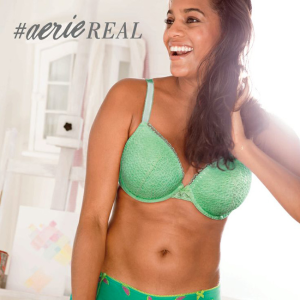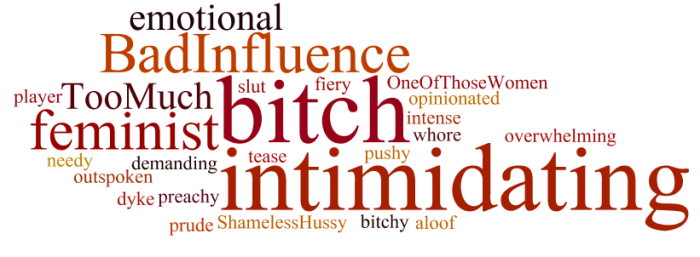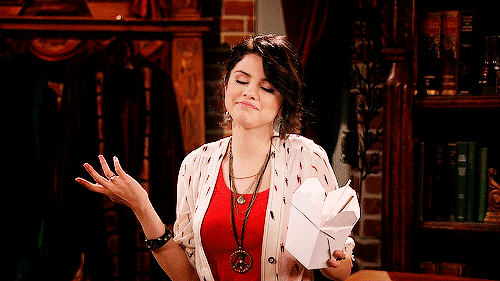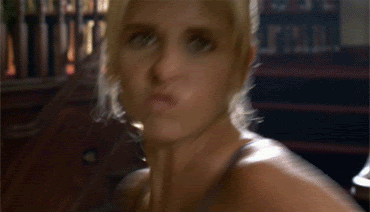Happy Monday, RLB readers!
I hope you’ve had you’re caffeine, because it isn’t even 9:00 am, and my double shot of espresso has me all ready to rouse some rabble.
At this point, it might seem like I’m harping on the subject. It’s possible that some of you are wondering if we’re going to change the name of our blog to Feminist Ads Are A-Okay! or Brought to You by Dove Real Beauty™
I promise, as the Oscars draw nearer there will plenty to say about women in Hollywood, and when the school year calms down S will have more time to dig up kick-ass lesser-known lady artists to introduce you to.
For now, we’re going to talk about the Aerie Real campaign. I can already hear some of your feathers ruffling, and that’s perfectly okay. We are all entitled to our opinions, and here is mine:
First, the skinny (was that pun in bad taste?): The lingerie line from American Eagle has started a new campaign called Aerie Real, wherein their models are not photoshopped or retouched. Their tagline is “the real you is sexy”.
I wasn’t even sure I was going to write about this, since it’s a subject we here at RLB have covered somewhat extensively. Then I read this post, from an irate writer over at PolicyMic. Let me start by saying she has some valid points. Let me also say that it was harder to connect to them because of the glaringly egregious claim in her headline: “This Isn’t ‘What Girls Really Look Like.'”
Excuse the shouting, but YES IT IS.
This is exactly what these girls really look like. Counting them out because they’re thin or fit is akin to the erroneous phrase (yet charming film) “real women have curves.” Real women come in all shapes and sizes, which is, I understand, the fundamental point of the PolicyMic article. Aerie could and should do more to represent more types of girls and young women. I agree! But I do not think it’s helpful to snark away the steps that are being taken toward that kind of representation. My point of view is more aligned with this writer over at a site I’d never heard of called Neon Tommy.
Here’s where I disagree with Neon Tommy: Yes, these models are still made up and styled by professionals. Because they’re models. Styling ones subjects is the standard for anyone being photographed for any ad/article/feature anywhere ever – even for feminist tomes such as BUST and Curve magazine.
Here’s the whole truth: I believe these are the seeds of a revolution. Seriously. When have we ever, as a collective culture, talked this much about how women are represented in the media, how unrealistic beauty standards are, and how women need to be valued for more than how they look? As far as I can recall, these questions have gone unasked because their answers were taken for granted as part of the status quo. Challenging the status quo, even in small ways, is how we provoke change. Have you ever, really, seen a girl like this in a lingerie ad? A lingerie ad that isn’t for “plus size” women?

If you think it’s egregious for me to claim that this girl could be considered plus size, it isn’t me. It’s the industry that we’re fighting against. There are many companies that will use models who are size 10-12 as “plus size,” and casting directors who even claim that “plus size” equals a size 8.
Every revolution starts with a spark. The 19th Amendment was ratified in 1920, and many agree that the suffragist movement leading to that moment began with an 1848 conversation in Seneca Falls. People point to Stonewall and Brown vs. The Board of Education as pivotal moments in history, but anyone who has ever been part of a movement knows – there were countless conversations that built up to and fueled those confrontations. There were small steps and quiet steps and virtually unnoticed steps. And they all led to major shifts in our culture.
Do you think it’s pretentious hyperbole for me to equate body positivity with women’s suffrage, the fight for queer equality, or the civil rights movement? Then let me leave you with some not so fun facts (all emphasis is mine):
- Girls between ages 11-14 see, on average, 500 ads a day.
- 53% of 13-year-old girls are unhappy with their bodies. That number increases to 78% by age 17.
- The number of cosmetic surgical procedures performed on youth under age 19 more than tripled from 1997 to 2007.
- 42% percent of first to third-grade girls want to be thinner, while 81% of 10-year-olds are afraid of getting fat.
- 80% of 10-year-old American girls say they have been on a diet. The number one magic wish for young girls age 11-17 is to be thinner.
- It is estimated that 8 million Americans have an eating disorder – seven million women and one million men.
- Eating disorders have the highest mortality rate of any mental illness.
- Adolescents with negative body image concerns are more likely to be depressed, anxious, and suicidal than those without intense dissatisfaction over their appearance, even when compared to adolescents with other psychiatric illnesses.
When I had the honor of meeting Bella Abzug back in 1996, I asked her if she had any advice for a young upstart like myself. “Choose your battles,” she said. “Women want to fix everything, but you’ll spread yourself too thin that way. Choose your battles, and fight for what matters most to you.”
So I choose body positivity as one of my battles. I choose to celebrate all victories, small and large, as necessary steps to winning the revolution of cultural change.
There is still a lot of work to do, in order to create a world for our daughters and nieces and granddaughters where they will be valued for who they are and what they have to contribute. These feminist ads aren’t a magical solution, and they aren’t the only answer; and right now most of them could push even harder and further toward change.
It doesn’t feel like enough because it isn’t enough, but it is a beginning.
Statistics gathered from:
http://www.sciencedaily.com/releases/2006/06/060606224541.htm
http://therepresentationproject.org/statistics
http://www.state.sc.us/dmh/anorexia/statistics.htm
http://justthink.org/




